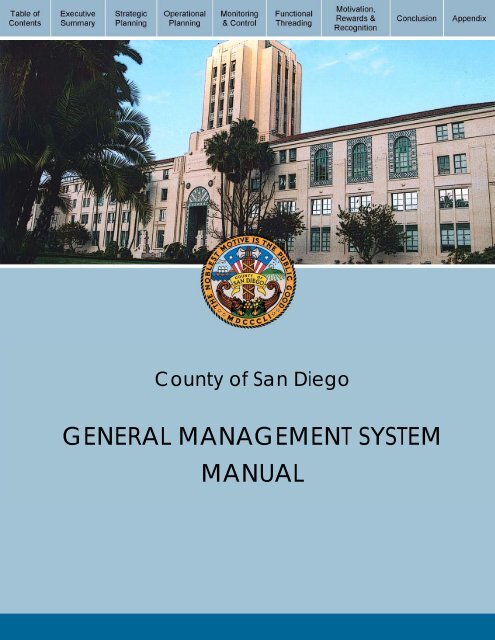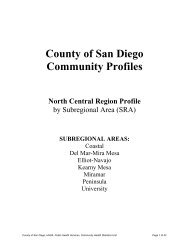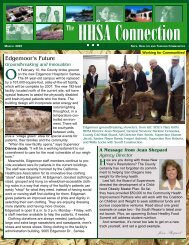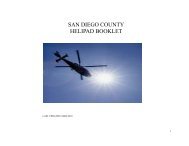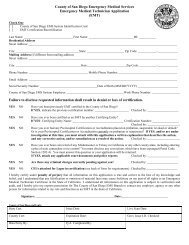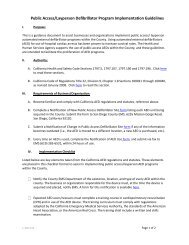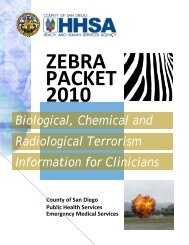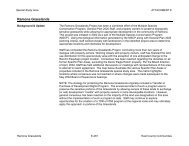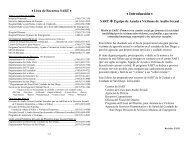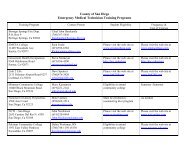General Management System - County of San Diego
General Management System - County of San Diego
General Management System - County of San Diego
You also want an ePaper? Increase the reach of your titles
YUMPU automatically turns print PDFs into web optimized ePapers that Google loves.
<strong>County</strong> <strong>of</strong> <strong>San</strong> <strong>Diego</strong><br />
GENERAL MANAGEMENT SYSTEM<br />
MANUAL
Table <strong>of</strong> Contents<br />
Executive Summary<br />
What Is GMS? ......................................................................................................... 1<br />
Why Is the GMS Necessary?................................................................................... 2<br />
What Is the History <strong>of</strong> the GMS? ............................................................................. 2<br />
Who Is Responsible for the GMS Implementation? ................................................. 2<br />
What Are the GMS Basics? ..................................................................................... 3<br />
Strategic Planning<br />
Overview.................................................................................................................. 4<br />
Strategic Planning Step-by-Step.............................................................................. 5<br />
Operational Planning<br />
Overview.................................................................................................................. 7<br />
Linking the Operational Plan to the Strategic Plan................................................... 7<br />
The <strong>County</strong>’s Operational Planning Process ........................................................... 8<br />
Contents <strong>of</strong> the Operational Plan Document............................................................ 9<br />
Monitoring and Control<br />
Overview................................................................................................................ 10<br />
Performance Measurement ................................................................................... 10<br />
Examples <strong>of</strong> Monitoring and Control Evaluation Tools .......................................... 12<br />
Functional Threading<br />
Overview................................................................................................................ 13<br />
Who Is Responsible for Functional Threading? ..................................................... 13<br />
Functional Threading in Action .............................................................................. 14<br />
Motivation, Rewards, and Recognition<br />
Overview................................................................................................................ 15<br />
The <strong>County</strong>’s Motivation, Rewards, and Recognition Programs ............................ 16<br />
Conclusion<br />
Additional Resources............................................................................................. 19<br />
Appendix<br />
Glossary <strong>of</strong> GMS Terms and Acronyms................................................................. 20
Executive Summary<br />
While it may be easy for government to move from crisis to crisis never thinking about<br />
an overall strategy to maintain stability and efficiency under the future challenges <strong>of</strong><br />
day-to-day governing, the <strong>County</strong> <strong>of</strong> <strong>San</strong> <strong>Diego</strong> operates quite differently. As a local<br />
government, the <strong>County</strong> exists to serve the residents <strong>of</strong> the region. As such, the <strong>County</strong><br />
<strong>of</strong> <strong>San</strong> <strong>Diego</strong> is committed to providing the best possible services to residents, as<br />
efficiently and effectively as possible.<br />
To achieve and maintain this level <strong>of</strong> operational excellence, we have chosen to<br />
implement a comprehensive way <strong>of</strong> doing business by adopting the <strong>General</strong><br />
<strong>Management</strong> <strong>System</strong> (GMS). This five-part annual cycle <strong>of</strong> planning, implementation,<br />
monitoring, and evaluation ensures that the priorities set by the Board <strong>of</strong> Supervisors<br />
are clear, that goals are achieved, and that <strong>San</strong> <strong>Diego</strong> <strong>County</strong> government is<br />
accountable to the public we serve.<br />
Our commitment to operational excellence and accountability is the foundation <strong>of</strong> the<br />
<strong>General</strong> <strong>Management</strong> <strong>System</strong>, and it provides the framework all departments and<br />
programs use to carry out our mission with consistency and excellence.<br />
What Is GMS?<br />
The GMS is a framework that establishes and guides <strong>County</strong> operations and service<br />
delivery to residents, businesses and visitors. Using the GMS, the <strong>County</strong> sets goals,<br />
prioritizes resources, evaluates performance, ensures cooperation and rewards<br />
accomplishments in a structured and coordinated way. By doing so, we have moved<br />
<strong>San</strong> <strong>Diego</strong> <strong>County</strong> away from the negative image <strong>of</strong> “red tape”<br />
and “government bureaucracy” into an organization that values<br />
and implements efficiency, innovation and fiscal discipline and<br />
one that provides focused, meaningful services to improve<br />
lives and benefit the community.<br />
The five-step system completes a full cycle in a fiscal year.<br />
The GMS process begins with creating a long-range, five-year<br />
Strategic Plan. This is followed by developing a short-term,<br />
two-year Operational Plan, which encompasses the budget<br />
process. Monitoring and Control takes place throughout the<br />
year using performance measures. Functional Threading<br />
maximizes efficient use <strong>of</strong> personnel and material resources<br />
by coordinating staff. Motivation, Rewards and Recognition<br />
encourages continuing excellence by rewarding employees who meet and exceed<br />
goals. At the beginning <strong>of</strong> the next fiscal year, the process begins again with a review<br />
<strong>of</strong> the Strategic Plan and development <strong>of</strong> a new Operational Plan.<br />
1
Why Is the GMS Necessary?<br />
In a word, the GMS is about excellence. The idea behind the GMS is straightforward:<br />
the <strong>County</strong> will be able to provide superior services if we set sound goals and apply<br />
strong management principles to achieve those goals.<br />
With an annual budget <strong>of</strong> approximately $4 billion and roughly 17,000 employees who<br />
serve more than 3 million residents spread across 4,000 square miles, coordination,<br />
fiscal and operational discipline, and shared commitment are<br />
vital. The GMS enables the <strong>County</strong> to set <strong>County</strong>-wide goals<br />
and then link the goal-setting to goal-attainment.<br />
A coherent management system helps ensure that all <strong>County</strong><br />
employees adhere to core principles, promoting a culture that<br />
values employees, partners, and customers. The GMS<br />
institutionalizes disciplines such as continuous improvement,<br />
fiscal integrity, transparency and accountability.<br />
What Is the History <strong>of</strong> the GMS?<br />
The idea behind the<br />
GMS is straightforward:<br />
the <strong>County</strong> will be able<br />
to provide superior<br />
services if we set sound<br />
goals and apply strong<br />
management principles<br />
to achieve those goals.<br />
On April 21, 1998, the Board <strong>of</strong> Supervisors accepted the<br />
GMS as the formal comprehensive guide for planning,<br />
implementing, and monitoring all functions and processes that affect delivery <strong>of</strong><br />
services to <strong>San</strong> <strong>Diego</strong> <strong>County</strong> residents. The <strong>County</strong> developed the GMS following the<br />
severe fiscal crisis that threatened <strong>County</strong> programs and solvency in the mid-1990s.<br />
When Is the GMS Used?<br />
The GMS is much more than a crisis management tool for putting the <strong>County</strong>’s fiscal<br />
house in order. It is an ongoing system that ensures sound management becomes a<br />
part <strong>of</strong> our permanent organizational culture. The principles and procedures outlined by<br />
the GMS are meant to apply to every <strong>County</strong> function on a year-round basis.<br />
Who Is Responsible for the GMS Implementation?<br />
Every <strong>County</strong> employee should know the GMS and their role in it. To achieve our goals,<br />
employees must share a sense <strong>of</strong> ownership and responsibility. Despite the important<br />
role <strong>of</strong> management, successful GMS application depends on strong and effective<br />
leadership at all levels <strong>of</strong> <strong>County</strong> service. Every <strong>County</strong> employee is expected to help<br />
set goals, strive to achieve them, monitor performance and reward achievement.<br />
2
What Are the GMS Basics?<br />
The GMS is a closed loop <strong>of</strong> five overlapping elements that form an ongoing cycle.<br />
Each element ensures that the <strong>County</strong> asks and answers crucial questions.<br />
GMS Element Question Asked Element Description<br />
Strategic Planning<br />
Where do we want<br />
to go?<br />
Our Strategic Plan looks ahead five years to<br />
anticipate significant needs, challenges, and<br />
risks that are likely to develop. Long-range<br />
planning requires assessing both where we<br />
are and where we want to be.<br />
Operational Planning How do we get<br />
there from here?<br />
Operational Planning allocates resources to<br />
specific programs and services that support<br />
our long-term goals over the next two fiscal<br />
years. This includes adoption <strong>of</strong> an annual<br />
budget and approval in principle <strong>of</strong> a second<br />
year spending plan.<br />
Monitoring and<br />
Control<br />
Functional<br />
Threading<br />
Motivation, Rewards,<br />
and Recognition<br />
How is our<br />
performance?<br />
Are we working<br />
together?<br />
Are we<br />
encouraging<br />
excellence?<br />
Monitoring and Control shows us whether we<br />
are on track to achieve our goals. We evaluate<br />
progress at regular intervals and make<br />
necessary adjustments. Progress is evaluated<br />
monthly, quarterly, and annually.<br />
Although the <strong>County</strong> is divided into distinct<br />
groups, departments and divisions for<br />
operational purposes, the <strong>County</strong> has many<br />
critical functions and goals that cross these<br />
organizational lines. Functional threading<br />
ensures coordination throughout the<br />
organization to pursue shared goals, solve<br />
problems, and exchange information.<br />
<strong>County</strong> employees must embrace the GMS<br />
and understand how the process applies to<br />
their individual job. This requires setting clear<br />
expectations, providing incentives, evaluating<br />
performance, and rewarding those who meet<br />
or exceed expectations. Motivation, Rewards<br />
and Recognition encourages individual and<br />
group excellence.<br />
3
Strategic Planning<br />
Where do we want to go?<br />
Overview<br />
Effective planning requires that we know not only what we want to accomplish, but also<br />
what resources we have and how best to use them. Successful planning identifies the<br />
obstacles we face and determines what change is needed to succeed.<br />
The <strong>County</strong>’s Strategic Plan charts the course for accomplishing our mission <strong>of</strong> serving<br />
the residents <strong>of</strong> <strong>San</strong> <strong>Diego</strong> <strong>County</strong> over a five-year period. The <strong>County</strong>’s strategic<br />
planning process defines major projects and initiatives, and anticipates significant<br />
needs, challenges and risks.<br />
The process begins by asking the following questions:<br />
Where do we want to go?<br />
Where do we want to be in five years?<br />
Where are we today?<br />
How will we get there?<br />
What factors will have an impact on our plans?<br />
Strategic planning is a continuous process. In many ways, this process is as valuable<br />
as the plan itself. At the <strong>County</strong>wide level, the process is coordinated by a team <strong>of</strong><br />
representatives <strong>of</strong> the Chief Administrative Officer (CAO), group <strong>General</strong><br />
Managers/Deputy CAOs (DCAOs), Human Resources Director, Office <strong>of</strong> Financial<br />
Planning, Chief Information Officer, and the Director <strong>of</strong> Media and Public Relations.<br />
Because <strong>of</strong> their key role in the strategic planning process, this team is known as the<br />
Strategic Planning Support Team (SPST).<br />
Building on the information shared by a variety <strong>of</strong> subject area experts, the SPST looks<br />
at what the <strong>County</strong> is doing well, where we can improve, and at any favorable or<br />
unfavorable conditions that impact the <strong>County</strong>. This analysis forms a critical component<br />
<strong>of</strong> assessing our direction in future years and forms the basis <strong>of</strong> the <strong>County</strong>’s Strategic<br />
Plan. SPST proposes revisions to the Strategic Plan if needed, to ensure <strong>County</strong> goals<br />
are relevant and meaningful. These proposed revisions are presented to the <strong>General</strong><br />
Managers/DCAOs and the CAO for their consideration.<br />
The CAO and <strong>General</strong> Managers/DCAOs use this information to develop the Five-Year<br />
Financial Forecast, a forward-looking projection <strong>of</strong> all resources required to implement<br />
the Strategic Plan. Finally the individual Strategic Plans <strong>of</strong> groups and departments are<br />
aligned with the <strong>County</strong>’s five-year Strategic Plan.<br />
4
Strategic Planning Step-by-Step<br />
Step 1 – Review the <strong>County</strong>’s Mission, Vision, Guiding Principles,<br />
and Strategic Plan<br />
The essential first step in planning is to ask the following:<br />
What is the <strong>County</strong>’s purpose?<br />
What are the ideals we value and hope to achieve?<br />
What principles guide us?<br />
We ask these questions to remind us who we are and where we want to be. The<br />
<strong>County</strong>’s Mission, Vision, Guiding Principles and Strategic Plan provide the context for<br />
making planning decisions. Any strategic planning effort must fulfill the <strong>County</strong>’s<br />
Mission, move the <strong>County</strong> toward realizing its Vision, and uphold our Guiding Principles.<br />
Step 2 – Perform a Gap Analysis<br />
The SPST conducts an analysis to identify whether there are any gaps between what<br />
the <strong>County</strong> says we’re going to do in our Strategic Plan and what we are actually doing<br />
in the Operational Plan. In other words, does our plan match our budget and vice<br />
versa? This gap analysis focuses attention on areas that may not be moving forward<br />
and helps ensure that resource allocation reflects the <strong>County</strong>’s strategy.<br />
Step 3 – Perform/Update Environmental Scan<br />
SPST conducts an Environmental Scan to identify the internal and external factors that<br />
affect <strong>County</strong> activities and change stakeholder expectations. To perform the<br />
Environmental Scan, SPST asks the following questions <strong>of</strong> various subject matter<br />
experts:<br />
How does the outside environment affect the <strong>County</strong>’s ability to function?<br />
What events beyond <strong>County</strong> control may affect service demand? Or funding?<br />
What are the internal and external risks to the <strong>County</strong>?<br />
What changes are occurring in regional socio-economic trends that may affect<br />
the <strong>County</strong>?<br />
5
Step 4 – Perform a Strengths, Weaknesses, Opportunities, and<br />
Threats (SWOT) Analysis<br />
Building on the observations <strong>of</strong> the Environmental Scan, the SPST conducts a<br />
SWOT analysis that looks comprehensively at the <strong>County</strong> organization to ask<br />
the following:<br />
What does the <strong>County</strong> do well? What are our strengths?<br />
Which areas can be improved? What are our weaknesses?<br />
What is the <strong>County</strong>’s fiscal situation?<br />
What is the status <strong>of</strong> <strong>County</strong> employees’ experience and efficiency?<br />
How well is the <strong>County</strong> providing services?<br />
What is the <strong>County</strong>’s unrealized potential? What opportunities exist?<br />
What threats face the <strong>County</strong>?<br />
Step 5 – Define or Reconsider Strategic Initiatives<br />
Based on the information identified in the Gap Analysis, the Environmental Scan, and<br />
the SWOT analysis, the SPST reexamines the Strategic Plan and its Strategic<br />
Initiatives and suggests refinements as necessary. The Strategic Initiatives define our<br />
priorities and focus our efforts. The Strategic Initiatives are broad organization-wide<br />
goals that move the <strong>County</strong> from abstract ideals and values to more concrete<br />
applications.<br />
Step 6 – Develop the Five-Year Financial Forecast<br />
The final step in strategic planning occurs when the <strong>General</strong> Managers/DCAOs<br />
evaluate the resources needed to achieve <strong>County</strong> goals, and develop the Five-Year<br />
Financial Forecast. The forecast includes a projection <strong>of</strong> resources required to<br />
implement new initiatives, and to continue or adjust existing programs. Key questions in<br />
developing the Five-Year Financial Forecast include:<br />
What are the trends for revenue, expenditures, and staff years?<br />
What has previously affected those trends and what may affect them in the<br />
future?<br />
What impacts will new initiatives have on existing resources?<br />
What resources will be necessary to make continuous improvements in service?<br />
What funding sources are expected over the next five years? What new sources<br />
are available? What existing sources will decrease or end?<br />
6
Operational Planning<br />
How do we get there from here?<br />
Overview<br />
If Strategic Planning tells us where the <strong>County</strong> is going, Operational Planning allocates<br />
the money and the staff to get there. During the creation <strong>of</strong> the two-year Operational<br />
Plan, which is the <strong>County</strong>’s budget process, resources are allocated to certain projects.<br />
As part <strong>of</strong> operational planning, we ask:<br />
What does the <strong>County</strong> want to accomplish during the next two years?<br />
How do our two-year objectives contribute to meeting our five-year strategic<br />
goals?<br />
How will we fund and staff <strong>County</strong> programs?<br />
The Operational Planning element <strong>of</strong> the GMS puts the Strategic Plan into action. You<br />
may remember, the final step <strong>of</strong> the Strategic Planning process is the creation <strong>of</strong> a<br />
Five-Year Financial Forecast. The first two years <strong>of</strong> the Five-Year Financial Forecast<br />
are used to develop the <strong>County</strong>’s Operational Plan or budget. Specifically, Operational<br />
Planning focuses on short-term fiscal planning and ultimately results in the <strong>of</strong>ficial<br />
document prepared by the CAO and adopted by the Board <strong>of</strong> Supervisors as the<br />
<strong>County</strong>’s budget.<br />
Because the State Government Code requires the Board <strong>of</strong> Supervisors to adopt a<br />
budget each year, the Board may only formally adopt the first year <strong>of</strong> the Two-Year<br />
Operational Plan. The Board approves the second year in principle for planning<br />
purposes.<br />
Linking the Operational Plan To the Strategic Plan<br />
It is critical that our Operational Plan supports the goals laid out in the Strategic Plan.<br />
The Operational Plan creates a direct link between our Strategic Plan goals and<br />
specific programs, staffing, and costs.<br />
As such, development <strong>of</strong> the Operational Plan occurs using the <strong>County</strong>’s Strategic Plan<br />
as a guide. <strong>County</strong> groups and departments prepare budget recommendations, review<br />
or develop programs, and determine staffing using the following questions:<br />
7
Does the expenditure bring us closer to our goals?<br />
Is the program mandated by state or federal law? Are we meeting these legal,<br />
regulatory, or funding requirements?<br />
Can we leverage resources through internal or external partnerships, or grant<br />
funding?<br />
How will resource changes affect other programs?<br />
If external funding is eliminated, is a <strong>County</strong> expenditure still justified?<br />
The <strong>County</strong>’s Operational Planning Process<br />
In many ways, preparation for next year’s budget begins as soon as the ink is dry on<br />
the current year’s budget. In January or February <strong>of</strong> each year, the Chief Financial<br />
Officer distributes the initial Two-Year Operational Plan instructions to <strong>County</strong><br />
departments. These instructions provide both general information about the operational<br />
planning process and detailed instructions for preparing the numerical and narrative<br />
sections <strong>of</strong> the Proposed Operational Plan.<br />
In late February or early March, department heads develop the Proposed Operational<br />
Plan objectives and the Operational Plan itself using the <strong>County</strong>’s Strategic Plan goals<br />
to guide their efforts.<br />
In May, the CAO submits the Proposed Operational Plan to the Board <strong>of</strong> Supervisors<br />
and the public. The Board formally accepts the document for review and holds public<br />
hearings in June. In mid-June, the CAO submits proposed changes, if any, to the Board.<br />
Additionally, Board members may submit proposed changes. These changes reflect<br />
modifications in revenues, expenditures, and priorities that have occurred since the<br />
Proposed Operational Plan was submitted. These modifications also take into account<br />
recent Board actions and public input from the budget hearings.<br />
In late June at the conclusion <strong>of</strong> public hearings, the Board deliberates, makes<br />
modifications, and approves the Operational Plan. Final Operational Plan adoption<br />
occurs in July or August. The lag time between approval in June and adoption in July or<br />
August is a required formality and allows the final Operational Plan to incorporate<br />
Board-approved modifications made during deliberations.<br />
8
Contents <strong>of</strong> the Operational Plan Document<br />
The Operational Plan document includes the following:<br />
<strong>General</strong> information about the <strong>County</strong> and the Operational Plan itself<br />
Narratives, tables, and charts showing the revenues and expenditures for all<br />
<strong>County</strong> funds<br />
A review <strong>of</strong> planned capital projects<br />
A summary <strong>of</strong> the <strong>County</strong>’s short and long-term financial obligations/debt<br />
A breakdown by group and department detailing the following:<br />
• The group/department mission<br />
• Prior year accomplishments<br />
• Operational objectives (derived from the Strategic Plan)<br />
• Changes to revenue, expenditures or staff levels from the prior year’s<br />
Operational Plan<br />
• Revenue amounts and sources<br />
• Expenditures and staffing by program<br />
• Performance measures and targets<br />
9
Monitoring and Control<br />
How is our performance?<br />
Overview<br />
The Strategic and Operational Plans set goals for the <strong>County</strong> and allocate needed<br />
resources to achieve those goals. The Monitoring and Control element <strong>of</strong> the GMS<br />
ensures <strong>County</strong> operations stay on target.<br />
Monitoring and Control challenges all <strong>County</strong> employees to regularly ask:<br />
Are we on track?<br />
Are groups and departments meeting their customer service, financial, and<br />
performance goals?<br />
Are individual managers effectively using resources and exercising needed<br />
leadership?<br />
Are projects producing desired results on time and within cost constraints?<br />
What needs to be done to correct identified deficiencies?<br />
Monitoring and Control is the process <strong>of</strong> scrutinizing our operations in order to track<br />
progress and make necessary adjustments. Many review methods exist for formal<br />
evaluations <strong>of</strong> various functions. These evaluations occur on a monthly, quarterly, and<br />
annual basis at different levels to monitor and assess projects, managers, departments<br />
and groups. The table that follows on the next page details primary <strong>County</strong> Monitoring<br />
and Control tools.<br />
Performance Measurement<br />
As part <strong>of</strong> ongoing Monitoring and Control efforts, the <strong>County</strong> makes regular use <strong>of</strong><br />
performance measures, key data that help track how the <strong>County</strong> is doing by comparing<br />
the same information over time. Developing and using performance measures allows<br />
the <strong>County</strong> to translate our Strategic Initiatives into coherent and quantifiable results.<br />
Performance measures also create a common set <strong>of</strong> expectations for group,<br />
department, project and employee performance, helping everyone on the <strong>County</strong> team<br />
work toward the goals laid out in our Strategic and Operational Plans. Translating<br />
organizational objectives into everyday tasks allows each employee to identify his<br />
contribution to the achievement <strong>of</strong> the <strong>County</strong>’s goals.<br />
10
Quantifying our performance also gives the <strong>County</strong> the ability to report both internally<br />
and to the public about our progress and impact in the community. Performance<br />
measures are useful to help identify and make necessary changes when performance<br />
doesn’t meet expectations, as well as to reward a job well done. Our performance<br />
measures tell us whether our efforts produce desired results, alert us to unintended<br />
consequences, and guide needed course corrections. In general terms, the <strong>County</strong>’s<br />
performance measures track:<br />
Outcomes – results<br />
Quality – degree <strong>of</strong> excellence<br />
As applied to the <strong>County</strong>, there are generally four perspectives under which measures<br />
are categorized:<br />
Perspective<br />
Description<br />
Customer Perspective Pinpoints our target customers.<br />
Are we meeting their needs and expectations?<br />
Continuous<br />
Improvement Process<br />
Perspective<br />
Identifies ways <strong>of</strong> doing business at which the <strong>County</strong> must excel<br />
in order to accomplish our goals and best meet the needs <strong>of</strong><br />
citizens.<br />
Is there a better way?<br />
Employee Perspective Assesses the employee skill levels and support systems<br />
necessary to achieve our goals.<br />
Are we providing sufficient employee support and<br />
opportunities for continuous learning?<br />
Financial Perspective<br />
Tells us whether our financial performance is meeting our<br />
resource objectives.<br />
Are we delivering maximum cost-efficiency and value to our<br />
customers for each dollar spent?<br />
11
Examples <strong>of</strong> Monitoring and Control Evaluation Tools<br />
Tool<br />
CAO Goals and<br />
Accomplishments<br />
Quarterly Reviews<br />
Project <strong>Management</strong><br />
Reporting <strong>System</strong>s<br />
Department Reviews<br />
CFO and <strong>General</strong><br />
Manager’s Resource<br />
Allocation Review<br />
Business Process<br />
Reengineering and<br />
Continuous<br />
Improvement Projects<br />
Risk Overview<br />
Committee<br />
Audit Committee<br />
Description<br />
An annual written statement <strong>of</strong> goals and accomplishments submitted by<br />
the CAO to the Board <strong>of</strong> Supervisors.<br />
Reports from groups are prepared and presented orally to the Chief<br />
Administrative Officer (CAO) by each group <strong>General</strong> Manager/DCAO<br />
and management staff. Quarterly reviews cover specific management<br />
topics, as determined by the CAO, including regular reviews <strong>of</strong> each<br />
group’s fiscal and human resources data, program performance issues,<br />
customer service feedback and potential risks.<br />
Quarterly, specific projects are reviewed by the CAO and <strong>General</strong><br />
Managers/DCAOs through Contract Business Process Review (CBPR)<br />
and Project <strong>Management</strong> Review (PMR). These formal review panels<br />
provide an opportunity to report on a project’s cost, schedule status,<br />
performance measures, major risks and mitigation plans.<br />
Monthly, <strong>General</strong> Managers/DCAOs look over operational areas with<br />
their department heads to review performance measures and identify<br />
risks as soon as possible.<br />
Every two weeks, the <strong>General</strong> Managers/DCAOs review and reassess<br />
group budget decisions based on current events, available resources,<br />
and priorities.<br />
There are always government services or processes that can be<br />
improved. When these areas are identified, executives work with front<br />
line employees to create explicit performance targets, set deadlines, and<br />
develop strategies for improvement. These projects track our ability to<br />
provide new or improved services to citizens using fewer tax dollars.<br />
The Risk Overview Committee (ROC) meets quarterly to identify and<br />
address significant legal, financial, contractual and operational risks to<br />
the <strong>County</strong>. The ROC serves in an advisory role to the CAO and the<br />
Board <strong>of</strong> Supervisors, and is chaired by the Assistant CAO and <strong>County</strong><br />
Counsel.<br />
The Audit Committee meets quarterly and advises the CAO on matters<br />
relating to the <strong>County</strong>’s internal and external audits, including advice on<br />
risk assessments, internal controls and governance matters. The<br />
Committee is chaired by the Assistant CAO and includes the Chief<br />
Financial Officer, the Auditor & Controller, the <strong>County</strong>’s Chief <strong>of</strong> Audits<br />
and three independent members <strong>of</strong> the public.<br />
12
Functional Threading<br />
Are we working together?<br />
Overview<br />
Although the <strong>County</strong> organization is divided into distinct groups, departments, and<br />
divisions, many <strong>of</strong> its critical functions cross organizational lines. Functional Threading<br />
is the process <strong>of</strong> ensuring coordination throughout our organization to pursue goals,<br />
solve problems, share information, and leverage resources. Functional Threading is a<br />
key element <strong>of</strong> the GMS, although it is also a way <strong>of</strong> doing business that stands on its<br />
own.<br />
For practical purposes, the <strong>County</strong> allocates resources by group and department.<br />
However, the purpose behind resource allocation is not simply to support these<br />
organizational units, but to accomplish our Strategic Initiatives – to support major<br />
undertakings that fulfill the <strong>County</strong>’s Mission, Vision, and Guiding Principles. Functional<br />
Threading helps us work together to better serve the public and to achieve our shared<br />
goals.<br />
Functional Threading looks at day-to-day operations and asks:<br />
How can we work together to accomplish our goals?<br />
What resources and expertise do we have?<br />
What <strong>County</strong> functions do we perform that are similar or related?<br />
Are these functions coordinated?<br />
Are resources, staff or expenditures duplicated?<br />
Who Is Responsible for Functional Threading?<br />
It is the ongoing responsibility <strong>of</strong> department heads and <strong>General</strong> Managers/DCAOs to<br />
ensure that <strong>County</strong> employees work together to leverage resources and solve<br />
problems. Although management-level employees are specifically tasked with regular<br />
participation in threading activities, as a practical matter, Functional Threading should<br />
not be limited to only these employees.<br />
Project teams tasked specifically with threading activities can involve employees at<br />
many levels. Additionally, Functional Threading is performed on a regular basis by<br />
nearly everyone in the <strong>County</strong> organization through routine tasks like making<br />
constituent referrals between agencies or information sharing between inspectors.<br />
13
Functional Threading in Action<br />
Certain <strong>County</strong> functions are common to most departments. These include budgeting<br />
and finance, customer service, and information technology, to name a few. Day-to-day<br />
coordination and cooperation across our organizational lines is necessary to perform<br />
these common functions efficiently and consistently. Functional Threading occurs when<br />
individuals with similar job responsibilities communicate and collaborate to better<br />
perform their jobs and serve the organization and the public. To this end, the <strong>County</strong><br />
has regular meetings <strong>of</strong> all human resources staff, financial staff, public information<br />
<strong>of</strong>ficers, and others throughout the organization. The idea being that these<br />
pr<strong>of</strong>essionals have responsibilities that impact the <strong>County</strong> as a whole, and should<br />
collaborate and share expertise and resources unique to their roles.<br />
In addition to Functional Threading throughout the <strong>County</strong> by job responsibilities, the<br />
<strong>County</strong> also teams up across department lines when Functional Threading involves<br />
meeting <strong>County</strong>wide goals. For example, staff from various managerial levels will<br />
convene to move forward projects that have an organization-wide impact, or<br />
encompass the functions <strong>of</strong> many departments. Efforts<br />
such as emergency preparedness planning affect all<br />
<strong>County</strong> departments. Functional Threading gives us the<br />
ability to plan for emergencies in a comprehensive way by<br />
using the combined expertise <strong>of</strong> many people throughout<br />
our organization.<br />
Functional Threading<br />
gives us the ability to<br />
plan for emergencies in<br />
a comprehensive way by<br />
using the combined<br />
expertise <strong>of</strong> many<br />
people throughout our<br />
organization.<br />
14
Motivation, Rewards, and<br />
Recognition<br />
Are we working together?<br />
Overview<br />
Motivation, Rewards, and Recognition is the final piece <strong>of</strong> the<br />
GMS that engages our organization’s most valuable resource,<br />
the men and women <strong>of</strong> the <strong>County</strong> workforce. Motivation,<br />
Rewards and Recognition ensures that we reward excellence<br />
in employee performance by turning abstract concepts and<br />
goals into a clear, relevant, and personal obligation for each<br />
employee.<br />
How? By providing all <strong>County</strong> employees with:<br />
Clarity about what is expected on the job<br />
Clear understanding <strong>of</strong> what it takes to do the job well<br />
Meaningful incentives for meeting and exceeding<br />
expectations, including monetary rewards<br />
Motivation, Rewards,<br />
and Recognition<br />
ensures that we reward<br />
excellence in employee<br />
performance by turning<br />
abstract concepts and<br />
goals into a clear,<br />
relevant, and personal<br />
obligation for each<br />
employee.<br />
The strongest goals, budget and oversight are meaningless without the commitment <strong>of</strong><br />
people performing the work. When all members <strong>of</strong> the <strong>County</strong> team achieve excellence,<br />
we become an efficient and effective organization that provides superior services to<br />
benefit citizens and the community.<br />
How does the <strong>County</strong> instill the value <strong>of</strong> the GMS in every employee? Since we can’t<br />
simply issue a commitment to operational excellence with every <strong>County</strong> ID, specific<br />
tools and programs inform employees about job duties and expectations, evaluate<br />
performance and provide incentives for employees who do their jobs well. Motivation,<br />
Rewards, and Recognition also promotes employee development, encourages<br />
individual excellence and the initiative needed to achieve <strong>County</strong> goals. Simply stated,<br />
every employee has their own job expectations and if you meet or exceed them, you<br />
will be rewarded.<br />
15
The <strong>County</strong>’s Motivation, Rewards, and<br />
Recognition Programs*<br />
What/Who Description Award Type<br />
Performance-<br />
Based<br />
Advancement in<br />
Salary<br />
For classified<br />
employees<br />
Quality First<br />
For all permanent<br />
employees<br />
Operational<br />
Incentive Plan<br />
(OIP)<br />
For executives and<br />
unclassified<br />
managers<br />
Do-It-Better-By-<br />
Suggestion<br />
(DIBBS) Program<br />
For all permanent<br />
employees except<br />
executives and<br />
unclassified<br />
managers<br />
CAO Recognition<br />
Award<br />
For executives and<br />
unclassified<br />
managers<br />
Employee performance is reviewed annually<br />
using performance appraisals. New classified<br />
employees generally move up from step one<br />
after six months, with annual advancements<br />
following. Confidential and management<br />
employees are eligible for advancement to a<br />
higher salary within their class range.<br />
Employees may not advance if their overall<br />
performance was rated below standard.<br />
Quality First (QF) rewards contributions to<br />
countywide and departmental goals. Most<br />
employees have an annual Quality First plan<br />
that details specific goals and how to measure<br />
their achievement. Department heads submit<br />
all Quality First plans to their <strong>General</strong><br />
Manager/DCAO, who review and approve<br />
them. The QF plan is ultimately approved by<br />
the CAO. Performance in achieving identified<br />
goals determines payouts to employees<br />
Operational Incentive Plans (OIPs) are annual<br />
employee performance plans that serve as a<br />
self-evaluation and accountability tool. The<br />
CAO and top <strong>County</strong> executives set OIP<br />
categories that reflect the <strong>County</strong>’s Strategic<br />
Initiatives and CAO goals. <strong>General</strong><br />
Managers/DCAOs and department heads<br />
evaluate the OIP results submitted by the<br />
managers under their supervision and make<br />
recommendations to the Executive<br />
Compensation Committee.<br />
The Do-It-Better-By-Suggestion (DIBBS)<br />
Program accepts and evaluates employee<br />
suggestions for improvements. Employees can<br />
submit ideas for improving operations,<br />
customer service, cost efficiency or improved<br />
safety. The basis for the award is approval and<br />
implementation <strong>of</strong> the employee’s suggestion.<br />
These awards are made at the discretion <strong>of</strong> the<br />
CAO for special contributions by managers<br />
who are otherwise ineligible for DIBBS.<br />
Approximately five percent<br />
difference between salary steps<br />
for classified employees in step<br />
classes. Percentage<br />
advancement varies at the<br />
discretion <strong>of</strong> the appointing<br />
authority for confidential and<br />
management employees in broad<br />
band classes.<br />
Employees can be awarded as<br />
much as four percent <strong>of</strong> annual<br />
salary. These temporary salary<br />
increases are paid out over six<br />
pay periods.<br />
Based on the OIP results,<br />
individual salaries are adjusted.<br />
Pay increases are based on<br />
meeting and exceeding goals.<br />
Failure to achieve goals may<br />
result in a base pay reduction.<br />
DIBBS awardees attend a<br />
<strong>County</strong>wide recognition<br />
ceremony. DIBBS awardees can<br />
receive a one-time cash award up<br />
to $20,000 based in part on the<br />
amount <strong>of</strong> savings the suggestion<br />
produces.<br />
A one-time cash award <strong>of</strong> up to<br />
ten percent <strong>of</strong> salary, not to<br />
exceed $10,000.<br />
16
What/Who Description Award Type<br />
Department<br />
Employee<br />
Recognition and<br />
Award Programs<br />
For all employees<br />
At the discretion <strong>of</strong> their appointing authority,<br />
employees can be rewarded for exceptional<br />
performance above and beyond expectations.<br />
The program’s goal is to improve customer<br />
service while enhancing motivation and<br />
strengthening teamwork.<br />
Commendations, cash, nonmonetary<br />
awards, and/or<br />
recognition leave are given to<br />
individuals or groups <strong>of</strong><br />
employees. There is a maximum<br />
$1,000 total value for each<br />
separate award and a $1,000<br />
limit per fiscal year.<br />
* NOTE: In addition to the programs detailed in the above table, additional project and/or department-specific recognition<br />
activities are encouraged and take place throughout the year. The <strong>County</strong> also uses its publications to recognize<br />
employee excellence and accomplishments.<br />
17
Conclusion<br />
The <strong>County</strong> <strong>of</strong> <strong>San</strong> <strong>Diego</strong> works to provide the best possible service to residents while<br />
serving as responsible stewards <strong>of</strong> public dollars. How does a local government excel?<br />
At the <strong>County</strong> <strong>of</strong> <strong>San</strong> <strong>Diego</strong>, we’ve chosen a common sense strategy for making<br />
government work. We’ve built a culture <strong>of</strong> operational excellence through the adoption<br />
<strong>of</strong> the <strong>General</strong> <strong>Management</strong> <strong>System</strong> (GMS).<br />
The GMS serves as the <strong>County</strong>’s instruction manual for running an effective and<br />
accountable government. More than just a playbook, the elements <strong>of</strong> the GMS<br />
encompass an annual cycle that engages all employees on a daily basis.<br />
To briefly review the five elements <strong>of</strong> the GMS:<br />
Strategic Planning sets the <strong>County</strong>’s goals.<br />
Operational Planning allocates resources to achieve our goals.<br />
Monitoring and Control ensures that <strong>County</strong> operations remain on track and<br />
alerts us to any risks that may arise.<br />
Functional Threading promotes cooperation and sharing <strong>of</strong> expertise and<br />
resources.<br />
Motivation Rewards and Recognition engages the <strong>County</strong> workforce in<br />
turning abstract goals into daily success on the job.<br />
At the <strong>County</strong> <strong>of</strong> <strong>San</strong> <strong>Diego</strong> we pride ourselves on continuous improvement and<br />
excellence in our operations. Furthermore, we have been recognized frequently at the<br />
local, state and national levels for prudent management and government innovation.<br />
Working together, the Board <strong>of</strong> Supervisors, the CAO and a dedicated team <strong>of</strong> public<br />
employees have created an organization that values efficiency, innovation and fiscal<br />
discipline. Our programs provide focused, meaningful services that improve lives and<br />
benefit the community. It is the <strong>General</strong> <strong>Management</strong> <strong>System</strong> that makes the <strong>County</strong> <strong>of</strong><br />
<strong>San</strong> <strong>Diego</strong> a government <strong>of</strong> excellence.<br />
18
Additional Resources<br />
<strong>County</strong> employees:<br />
For additional resources and more information about the GMS including training<br />
materials and contact information, visit the <strong>County</strong>’s Intranet at: cww/gms<br />
For additional information about the Operational Plan and budgeting visit the<br />
Auditor and Controller’s <strong>of</strong>fice on the <strong>County</strong> Intranet at: cww/ac<br />
For information about when specific GMS activities occur throughout the<br />
calendar year, check the CAO Master Calendar, which is posted on the <strong>County</strong><br />
Intranet at: cww/cao<br />
Members <strong>of</strong> the public:<br />
For more information about the GMS, and a copy <strong>of</strong> the <strong>County</strong>’s Strategic Plan<br />
visit the CAO’s <strong>of</strong>fice on the Internet at www.sdcounty.ca.gov/cao<br />
For the <strong>County</strong>’s Operational Plan and other financial documents visit the<br />
Auditor and Controller’s <strong>of</strong>fice on the Internet at www.sdcounty.ca.gov/auditor<br />
19
Appendix<br />
Glossary <strong>of</strong> GMS Terms and Acronyms<br />
ACAO<br />
Appointing<br />
Authority<br />
Board <strong>of</strong><br />
Supervisors<br />
CAO<br />
DCAO<br />
Assistant Chief Administrative Officer.<br />
The elective or appointive <strong>of</strong>ficer <strong>of</strong> a department, <strong>of</strong>fice, board or<br />
commission <strong>of</strong> <strong>County</strong> government who has the power by <strong>County</strong><br />
Charter or by lawfully delegated authority to make appointments to or<br />
remove persons from positions.<br />
The elected governing and policy body for the <strong>County</strong> <strong>of</strong> <strong>San</strong> <strong>Diego</strong>.<br />
There are five members <strong>of</strong> the Board <strong>of</strong> Supervisors.<br />
Chief Administrative Officer. The CAO is the chief executive <strong>of</strong> the<br />
<strong>County</strong> who is appointed by the Board <strong>of</strong> Supervisors to carry out all<br />
<strong>of</strong> the Board’s policy decisions that impact <strong>County</strong> operations and to<br />
ensure the effective administration <strong>of</strong> <strong>County</strong> government.<br />
Deputy Chief Administrative Officer. See <strong>General</strong> Manager/DCAO.<br />
Environmental<br />
Scan<br />
Executive<br />
Compensation<br />
Committee<br />
Final or Adopted<br />
Operational Plan<br />
Gap Analysis<br />
<strong>General</strong><br />
Manager/DCAO<br />
A process by which subject matter experts meet with the SPST to<br />
share information about the internal and external factors that<br />
influence and drive <strong>County</strong> activities and stakeholder expectations.<br />
The Environmental Scan is performed annually as part <strong>of</strong> the<br />
Strategic Planning process<br />
Made up <strong>of</strong> the ACAO, <strong>General</strong> Managers/DCAO, CFO, <strong>County</strong><br />
Counsel, and Human Resources Director. The Executive<br />
Compensation Committee makes salary adjustment<br />
recommendations to the CAO for the unclassified service.<br />
The Operational Plan, as approved by the Board <strong>of</strong> Supervisors<br />
annually in late June and formally adopted in July or August. Also<br />
referred to as the <strong>County</strong>’s budget.<br />
An analysis performed by the SPST as part <strong>of</strong> the Strategic Planning<br />
Process. The Gap Analysis is used to determine whether there are<br />
any gaps between what the <strong>County</strong> says it’s going to do in its<br />
Strategic Plan and what it is actually doing.<br />
<strong>General</strong> Manager/Deputy Chief Administrative Officer (DCAO). The<br />
<strong>County</strong> has <strong>General</strong> Managers/DCAOs that oversee various<br />
business groupings <strong>of</strong> <strong>County</strong> departments. These individuals can be<br />
referred to using either the title <strong>of</strong> <strong>General</strong> Manager or Deputy Chief<br />
Administrative Officer (DCAO), or both. <strong>General</strong> Managers/DCAOs<br />
are responsible for implementing the Board <strong>of</strong> Supervisors’ and<br />
CAO’s policies and procedures in each department within their<br />
group.<br />
20
Glossary <strong>of</strong> GMS Terms and Acronyms<br />
GMS<br />
Group<br />
Guiding Principles<br />
<strong>General</strong> <strong>Management</strong> <strong>System</strong>. The GMS is a framework that guides<br />
planning, implementation, monitoring, coordination and evaluation to<br />
continuously improve the <strong>County</strong>’s delivery <strong>of</strong> services to residents,<br />
businesses and visitors.<br />
An organizational unit <strong>of</strong> departments within the <strong>County</strong> headed by a<br />
<strong>General</strong> Manager/DCAO.<br />
Statements <strong>of</strong> the <strong>County</strong>’s core values. These are the <strong>County</strong>’s<br />
ethical obligations to residents.<br />
Mission<br />
Proposed Change<br />
Letter<br />
Proposed<br />
Operational Plan<br />
Required<br />
Disciplines<br />
Resources<br />
SPST<br />
Strategic<br />
Indicators<br />
Strategic<br />
Initiatives<br />
SWOT<br />
States the purpose <strong>of</strong> <strong>County</strong> government.<br />
Modifications to the Proposed Operational Plan submitted by the<br />
CAO to the Board <strong>of</strong> Supervisors annually in mid-June to reflect<br />
revenues, expenditures, or priorities that change after the Proposed<br />
Operational Plan is introduced in May. Individual Supervisors may<br />
also submit Change Letters.<br />
The suggested or draft Operational Plan that the CAO submits for<br />
review to the Board <strong>of</strong> Supervisors and the public annually in May.<br />
Statements that identify the <strong>County</strong>’s standards for operational<br />
excellence. Required Disciplines are listed in the Strategic Plan.<br />
Items <strong>of</strong> value that are used to accomplish the <strong>County</strong>’s goals. The<br />
items include taxpayer dollars, employees and all <strong>San</strong> <strong>Diego</strong> <strong>County</strong><br />
assets, including natural and cultural resources, individual expertise<br />
and creativity, and the informed interest <strong>of</strong> <strong>County</strong> residents.<br />
Strategic Planning Support Team. This group is made up <strong>of</strong><br />
representatives from the following: the CAO, <strong>General</strong><br />
Managers/DCAOs, Human Resources Director, Chief Information<br />
Officer, Director <strong>of</strong> Media and Public Relations. The SPST plays an<br />
integral role in the <strong>County</strong>’s Strategic Planning process and works to<br />
support the GMS throughout the <strong>County</strong> organization.<br />
Statistics that identify big picture issues and trends that may<br />
influence or be affected by the <strong>County</strong>’s Strategic Initiatives and<br />
Required Disciplines.<br />
Statements that identify broad, organization-wide goals that help<br />
prioritize specific <strong>County</strong> efforts and programs. The <strong>County</strong>’s<br />
Strategic Initiatives are included in its Strategic Plan.<br />
Strengths, Weaknesses, Opportunities, and Threats. SWOT is a<br />
<strong>County</strong>-level analysis performed annually as part <strong>of</strong> the Strategic<br />
Planning process.<br />
21
Glossary <strong>of</strong> GMS Terms and Acronyms<br />
Two-Year<br />
Operational Plan<br />
Vision<br />
The <strong>County</strong>’s financial plan for the next two fiscal years, detailing<br />
each department’s objectives and the resources required to achieve<br />
them. This plan consists <strong>of</strong> two parts: a budget for the upcoming<br />
fiscal year which is formally adopted by the Board <strong>of</strong> Supervisors,<br />
and a proposed budget for the second fiscal year, which is approved<br />
in principle by the Board <strong>of</strong> Supervisors.<br />
Statement that refers to an ideal state we strive toward; what the<br />
<strong>County</strong> would like to be.<br />
22


